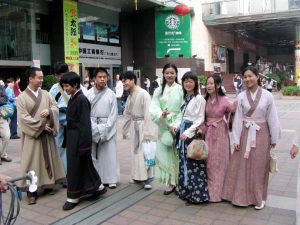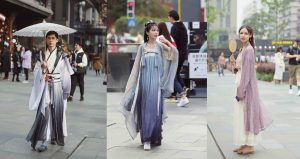15 Hanfu Culture Movement – 汉服运动 (Hànfú yùndòng)
Luo Ye (罗叶)
I
simplified Chinese: 汉服运动; pinyin: Hànfú yùndòng
Hanfu Culture Movement
n recent years, the Hanfu movement or known in Chinese as 汉服运动 (han4 fu2 yun4 dong4) which directly translates to Han’s people clothing revival movements has gained popularity in Chinese society. The Hanfu movement started in 2003 when a Chinese-Singaporean journalist name Zhang Congxing saw Wang Letian online wearing a Shenyi (深衣 , Deep clothing) style hanfu. Zhang Congxing decided to make an article about Wang Letian and his Hanfu. In prior years, many people tried to revive the use of the hanfu clothing for daily wear but failed. However, when Zhang Congxing published the article, many Chinese reflected and were influenced by ancient Han Chinese culture which ignited a spark for the birth of the Hanfu movement. In that same year, Wang Letian and other Hanfu enthusiasts created a website called Hanwang (漢網) to promote and spread the significant cultural value of the Hanfu. Therefore, Hanfu enthusiasts were convinced and interested in wanting to wear Hanfu in public. They planned activities and organizations related to the wear of the Hanfu clothes and experience traditional Chinese culture. However, with the hanfu popularity rising in the early days of the hanfu movement At that time, there were no shops selling Hanfu. Many people relied on tailors or relied on themselves to make the Hanfu clothing. In 2006 the store Chong hui Han tan opened It was the 1st Hanfu clothing store to open.

Recently, the Hanfu movement has gained more popularity. Since technology has advanced and more people have access to the internet, people are mesmerized by the Hanfu clothing. Also, with the rise of ancient Chinese traditional drama. The Hanfu has become a staple in Chinese entertainment and advertisement. The Hanfu has gained influence that in 2021 Cheng Xinxiang a lawmaker suggests changing the holiday Double Third Festival (三月三) which happens every 3rd month of the lunar calendar. This holiday originated from the Zhou Dynasty (about 1100-221 BC). Now Hanfu Enthusiasts were trying to replace this holiday renaming it to the National Hanfu day the Government refused this idea. Nevertheless, The Hanfu movement has been a great economic success for China and it is predicted that approximately $9 billion Yuan (US$ 1.39 billion dollars) will be generated by hanfu clothing in the coming years. Therefore, the Chinese are being influenced by the Hanfu movement. The members of the community are one step closer to trying to bring back old customs and traditions on a larger scale to bring forward their version of the “Chinese Dream.”

Citations
“2021 Latest Updates on the Hanfu Movement – Newhanfu.” Hanfu Forum & Community, 12 Nov. 2021, https://www.newhanfu.com/1147.html.
“5 Important Hanfu Festivals That Hanfu Lover Must Know – Newhanfu.” Hanfu Forum & Community, 25 Mar. 2022, https://www.newhanfu.com/25456.html#:~:text=The%20Chinese%20National%20Costume%20Day,the%20Han%20Chinese%20people%20in.
Chen, Xi. “Chinese Cultural Expert Refutes Lawmaker’s Proposal to Establish Day Dedicated to Traditional Chinese Costume at the Two Sessions.” Global Times, 7 Mar. 2021, https://www.globaltimes.cn/page/202103/1217601.shtml.
“Hanfu Movement.” Wikipedia, Wikimedia Foundation, 8 Feb. 2023, https://en.wikipedia.org/wiki/Hanfu_Movement.
“Hanfu.” 瀨谿珡伶散記 Accounts of the “Lutenist” from Beaver Creek, 11 May 2011, https://torguqin.wordpress.com/hanfu/.
Hong, Zehua. “China Focus: Hanfu-Led ‘China-Chic’ Trend Builds on Cultural Confidence.” Xinhua, 24 Feb. 2023, https://english.news.cn/20230224/70945905fdeb4d40b2e5695b0d66649f/c.html.
Zuo, Mandy. “’Cultural Power Not a Suit and Tie’: Hanfu Clothing Revival Spurs Sales Boom.” South China Morning Post, 27 Aug. 2022, https://www.scmp.com/news/people-culture/trending-china/article/3190171/cultural-power-not-suit-and-tie-hanfu.

